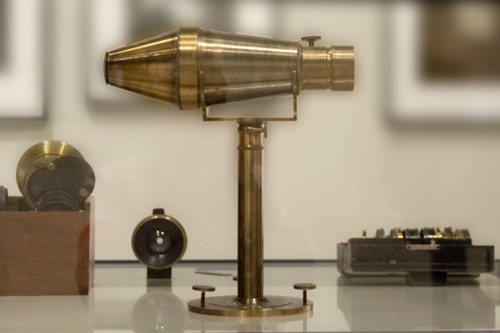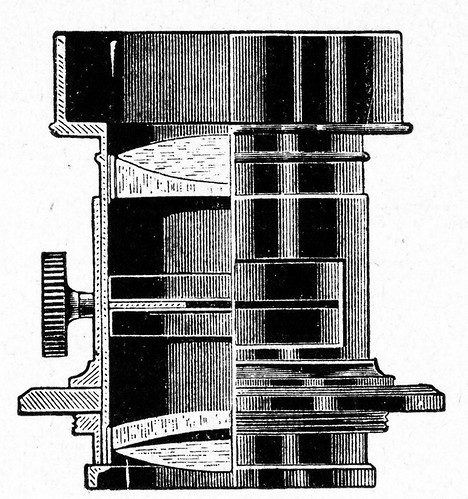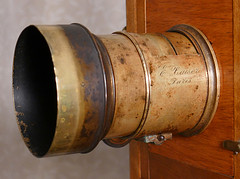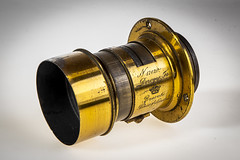Difference between revisions of "Petzval lens"
Hanskerensky (talk | contribs) (→Links: <!--Commented out link, page no longer present/available, please remove if not returned by 05/2016 -->) |
m (→Links: Updated LPA link) |
||
| (9 intermediate revisions by 5 users not shown) | |||
| Line 1: | Line 1: | ||
| + | {{Flickr image | ||
| + | | image_source=https://www.flickr.com/photos/148717487@N03/51575045519/in/pool-camerawiki/ | ||
| + | | image=https://live.staticflickr.com/65535/51575045519_cb5a2cbcf4.jpg | ||
| + | | image_align= center | ||
| + | | image_text= Replica of Voigtänder's camera that was equipped with the first Petzval lens<br>150 mm f/3.6 - original was from 1841<br> Nicephore Niépce Museum - Chalon sur Saône - France | ||
| + | | image_by= Wagner Lungov | ||
| + | | image_rights=non-commercial | ||
| + | }} | ||
| + | |||
| + | |||
{{Flickr image | {{Flickr image | ||
| Line 15: | Line 25: | ||
The lens gave sharp definition in the centre, but covered only a small field for its focal length, and tended to vignette.<ref>Greenleaf, Allen R. (1950) ''Photographic Optics''. Macmillan, New York. pp67-8.</ref> These features were quite acceptable for portraiture, and lenses based on the Petzval design remained in use for studio portraiture for many years.<ref>The [http://www.cineressources.net/consultationPdf/web/o000/173.pdf Ross Catalogue of 1912] (p 15), ''seventy years'' after Petzval's invention, states "''For Studio purposes the lenses employed have, until recently, been almost exclusively of the Petzval type. These excellent lenses give central sharpness for Busts and Single Figures, but for Groups and Pictures requiring more extensive covering our "Homocentrics" are now largely used, possessing as they do a defination'' (sic) ''more perfect both at centre and margin than any other Anastigmats.''"</ref> | The lens gave sharp definition in the centre, but covered only a small field for its focal length, and tended to vignette.<ref>Greenleaf, Allen R. (1950) ''Photographic Optics''. Macmillan, New York. pp67-8.</ref> These features were quite acceptable for portraiture, and lenses based on the Petzval design remained in use for studio portraiture for many years.<ref>The [http://www.cineressources.net/consultationPdf/web/o000/173.pdf Ross Catalogue of 1912] (p 15), ''seventy years'' after Petzval's invention, states "''For Studio purposes the lenses employed have, until recently, been almost exclusively of the Petzval type. These excellent lenses give central sharpness for Busts and Single Figures, but for Groups and Pictures requiring more extensive covering our "Homocentrics" are now largely used, possessing as they do a defination'' (sic) ''more perfect both at centre and margin than any other Anastigmats.''"</ref> | ||
| + | |||
| + | Field curvature of Petzval lens diminishes as lens is focused closer. Since most of 19th century cameras would be considered large format cameras today, the magnification for same object size (e.g. waist level portrait, face) was proportionally greater and therefore curvature smaller than for infinity focus. Such effect is not directly reproducible with same lens design on smaller format cameras.<ref>[http://www.penta-club.ru/forum/blog/14/entry-68-короткий-опус-о-кривизне-поля-изображения-стар/ Short opus about field curvature of old portait lenses]; in Russian</ref> | ||
| + | Secondary chromatism of Petzval lens is reduced compared because the first group operates at slower f-number than the entire lens. | ||
==Photos== | ==Photos== | ||
| Line 42: | Line 55: | ||
|image_rights= wp | |image_rights= wp | ||
}} | }} | ||
| − | |||
{{Flickr_image | {{Flickr_image | ||
|image_source= http://www.flickr.com/photos/tokyogaz/5455930454/in/pool-camerawiki/ | |image_source= http://www.flickr.com/photos/tokyogaz/5455930454/in/pool-camerawiki/ | ||
| Line 49: | Line 61: | ||
|image_text= Petzval lens by E. Baiser of Paris. | |image_text= Petzval lens by E. Baiser of Paris. | ||
|image_by= tokyogaz | |image_by= tokyogaz | ||
| + | |image_rights= with permission | ||
| + | }} | ||
| + | {{Flickr_image | ||
| + | |image_source= https://www.flickr.com/photos/7455207@N05/50891149297/in/pool-camerawiki/ | ||
| + | |image= https://live.staticflickr.com/65535/50891149297_b96fa6fa2e_m_d.jpg | ||
| + | |image_align= left | ||
| + | |image_text= Petzval lens by [[Derogy]] | ||
| + | |image_by= SBA73 | ||
|image_rights= with permission | |image_rights= with permission | ||
}} | }} | ||
| Line 55: | Line 75: | ||
<br style="clear:both;" /> | <br style="clear:both;" /> | ||
| + | |||
| + | ==Projection petzval lens== | ||
| + | A simplified design had significant use as projection lenses for film. It had second doublet cemented and its positive component placed anterior. | ||
==Notes== | ==Notes== | ||
| Line 60: | Line 83: | ||
==Links== | ==Links== | ||
| + | *[https://apenasimagens.com/en/the-petzval-portrait-lens/ The Petzval portrait lens history and why it is so special] by Wagner Lungov | ||
*[http://antiquecameras.net/petzvallens.html A History of the Petzval Lens] at [http://antiquecameras.net/ Antique and classic cameras] | *[http://antiquecameras.net/petzvallens.html A History of the Petzval Lens] at [http://antiquecameras.net/ Antique and classic cameras] | ||
| − | *[http://www.sinopt.com/software1/usrguide54/examples/petzval.htm Petzval lens brief] at [http://www.sinopt.com Sinclair Optics] | + | *[https://web.archive.org/web/20090725102011/http://www.sinopt.com/software1/usrguide54/examples/petzval.htm Petzval lens brief] at [https://web.archive.org/web/20090429032025/http://www.sinopt.com/ Sinclair Optics] (archived) |
*[http://en.wikipedia.org/wiki/Petzval_lens Petzval lens] article at [http://en.wikipedia.org/ Wikipedia] | *[http://en.wikipedia.org/wiki/Petzval_lens Petzval lens] article at [http://en.wikipedia.org/ Wikipedia] | ||
*[http://www.antiquecameras.net/softfocuslenses.html Antique & Classic Soft Focus Lens Article] | *[http://www.antiquecameras.net/softfocuslenses.html Antique & Classic Soft Focus Lens Article] | ||
| − | + | * The Petzval lens is discussed in [https://web.archive.org/web/20051103083315/http://pluslucis.univie.ac.at/FBA/FBA99/Sporn/8.pdf ''Der Österreichische Beitrag zur Fotografie''] (archived)(the Austrian contribution to photography), chapter 8 of [https://web.archive.org/web/20050310004058/http://pluslucis.univie.ac.at/FBA/FBA99/Sporn/index.html Historische Verfahren in der Fotografie] (archived) (Historical methods in photography) by Christian Sporn, a candidate for an award by the Österreichische Physikalische Gesellschaft in 1999; formerly hosted by the [https://www.pluslucis.org/Verein.html Verein zur Förderung des physikalischen und chemischen Unterrichts] (Association for the Promotion of Physical and Chemical Education) at the University of Vienna. | |
*[http://www.flickr.com/groups/868027@N25/ Petzval lens photographs] Flickr group | *[http://www.flickr.com/groups/868027@N25/ Petzval lens photographs] Flickr group | ||
*[http://dioptrique.info/base/i/i_petzval.HTM Objectif de Petzval] French article on design, 3rd order curves and images | *[http://dioptrique.info/base/i/i_petzval.HTM Objectif de Petzval] French article on design, 3rd order curves and images | ||
| − | * [ | + | * [https://www.leitz-auction.com/en/Voigtlaender-Petzval-Lens/AI-23-10273 35 cm Voigtländer Petzval lens], about 1863, sold at the [https://www.leitz-auction.com/en/Cameras/Past-Auctions/Auction-23/ 23rd Westlicht Photographica Auction], on 25 May 2013. |
[[Category:Lenses]] | [[Category:Lenses]] | ||
Latest revision as of 00:17, 21 January 2024

|
| Replica of Voigtänder's camera that was equipped with the first Petzval lens 150 mm f/3.6 - original was from 1841 Nicephore Niépce Museum - Chalon sur Saône - France image by Wagner Lungov (Image rights) |

|
| Half-section diagram of Petzval lens, from Voigtländer literature. scanned by Uwe Kulick (Image rights) |
The Petzval lens (or Petzval portrait lens) is the oldest notable lens design for photography. It was calculated and designed by the native Slovakian mathematician and physicist Jozef Maximilián Petzval, and first used for Voigtländer's early metal camera "Daguerreotyp-Apparat zum Portraitiren" in 1841. It was the first camera lens made on the basis of scientific calculation, and was the fastest lens of its time, with an aperture of around f/3.5 - compared to the f/16 or more of typical contemporary camera lenses. This could reduce the average Daguerreotype exposure time from around 10 minutes to 30 seconds.
The design has two separate doublet elements; the front one cemented and the rear one (in the original design) with an air gap (as shown in the illustration). An aperture stop is placed between the two doublets.
The lens gave sharp definition in the centre, but covered only a small field for its focal length, and tended to vignette.[1] These features were quite acceptable for portraiture, and lenses based on the Petzval design remained in use for studio portraiture for many years.[2]
Field curvature of Petzval lens diminishes as lens is focused closer. Since most of 19th century cameras would be considered large format cameras today, the magnification for same object size (e.g. waist level portrait, face) was proportionally greater and therefore curvature smaller than for infinity focus. Such effect is not directly reproducible with same lens design on smaller format cameras.[3] Secondary chromatism of Petzval lens is reduced compared because the first group operates at slower f-number than the entire lens.
Contents
Photos

|
| Voigtländer & Sohn Petzval lens image by Pete Strasser (Image rights) |

|
| Voigtländer & Sohn Petzval lens image by Pete Strasser (Image rights) |

|
| Voigtländer & Sohn Petzval lens image by Pete Strasser (Image rights) |

|
| Petzval lens by E. Baiser of Paris. image by tokyogaz (Image rights) |

|
| Petzval lens by Derogy image by SBA73 (Image rights) |
Projection petzval lens
A simplified design had significant use as projection lenses for film. It had second doublet cemented and its positive component placed anterior.
Notes
- ↑ Greenleaf, Allen R. (1950) Photographic Optics. Macmillan, New York. pp67-8.
- ↑ The Ross Catalogue of 1912 (p 15), seventy years after Petzval's invention, states "For Studio purposes the lenses employed have, until recently, been almost exclusively of the Petzval type. These excellent lenses give central sharpness for Busts and Single Figures, but for Groups and Pictures requiring more extensive covering our "Homocentrics" are now largely used, possessing as they do a defination (sic) more perfect both at centre and margin than any other Anastigmats."
- ↑ Short opus about field curvature of old portait lenses; in Russian
Links
- The Petzval portrait lens history and why it is so special by Wagner Lungov
- A History of the Petzval Lens at Antique and classic cameras
- Petzval lens brief at Sinclair Optics (archived)
- Petzval lens article at Wikipedia
- Antique & Classic Soft Focus Lens Article
- The Petzval lens is discussed in Der Österreichische Beitrag zur Fotografie (archived)(the Austrian contribution to photography), chapter 8 of Historische Verfahren in der Fotografie (archived) (Historical methods in photography) by Christian Sporn, a candidate for an award by the Österreichische Physikalische Gesellschaft in 1999; formerly hosted by the Verein zur Förderung des physikalischen und chemischen Unterrichts (Association for the Promotion of Physical and Chemical Education) at the University of Vienna.
- Petzval lens photographs Flickr group
- Objectif de Petzval French article on design, 3rd order curves and images
- 35 cm Voigtländer Petzval lens, about 1863, sold at the 23rd Westlicht Photographica Auction, on 25 May 2013.